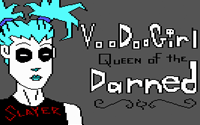|
|
||||||||||||
  
After playing the freeware AGI game, Voodoo Girl: Queen of the Darned, I had the unique opportunity to interview the game's producer, Andrew Ulysses Baker. Here's what he had to say about his experiences in pushing the envelope with the AGIStudio engine: First of all, let me just say, I played the game in its entirety, and I personally absolutely love it. I think you might actually be the first person to finish it other than me. Really? I'm surprised. Well, girls seem to like it more than guys, but there was a rather critical bug that I had to fix recently. What was the critical bug? The original release was tested with NAGI, which can manage stack and heap problems that the original interpreter couldn't swallow. In the caves where you have to find the pieces of Cthukasdjfkhdshhdfisfh (something)'s medallion, one of the rooms had a bit of code that referenced a non-existent sprite frame. On the original interpreter, it would totally bomb out. Interesting... I actually played it out on DOSBox, instead of NAGI, for the purpose of taking screenshots. It ran a little slow at times, most noticeably during the potion making and fighting bits. Other than that, was great. Not surprising. A lot of us in the community (http://mega-tokyo.com/forum) endeavored to push the original engine beyond its design. If you look at games like Enclosure or the upcoming Ninja Forever, it's all way beyond what Ken Williams had intended. The story and art of VG is quite a trip... where did you dream up the concept? It all started back when I got a hold of Gabriel Knight: Sins of the Fathers. That was such a classic, but a critical bug kept me from finishing it. But I was totally hooked on voodoo after that. I know the Voodoo Girl character came to me some time after, when I was making concert posters. She originally had a finger bone through her septum, but that sort of disappeared after a few hundred iterations. Ouch â?Š I noticed that a lot of the info on the religious aspects of voodoo were actually pretty accurate ... how did you do your research? Well, when I was younger, I actively studied theology and mythology. So, I actually knew a bit of voodoo fact and fiction. GK1 was a great stimulus for that, as it already had decent research for it. Although, it did take a few liberties. My sister Roxy even picked up a fetish doll and a gris-gris for my buddy and me when she went down to New Orleans for Mardi Gras. But my buddy and I threw them away after some freaky stuff happened. What sort of freaky stuff, and was it before or after you produced the game? Much before. Just a spate of some seriously bad luck. Well, I guess it didn't affect your interest in the subject, then, so the freeware gaming community can be thankful for your perseverance. I noticed that there are a lot of ... "colorful" ... characters and locations in VG. Where did you get these off-the-wall ideas, such as the insane asylum? Insane asylum would have to be One Flew Over the Cuckoo's Nest. The Incredibly Twisty Maze was from Labyrinth. The fishing game was inspired by Breath of Fire. Pretty much everything got thrown into it. So, how long did it take you to pull everything together and develop the game to completion? One year to the day. Wow, exactly? Was that planned, or just coincidence? I had never finished anything before. So, I made a promise I'd finish it in a year. No excuses. I managed to go from finding the engine, doing a demo, writing a working design document (a ratty notebook in ballpoint), and finishing the gold master release on New Year's Eve. Rock on, and congrats on a fulfilled New Years resolution. So, what was your favorite aspect of developing the game? And for that matter, what was your least favorite? Making a game makes me feel like a tiny god. Seriously, it's like the best Sim City game ever, where I get to decide how everything works. That's a very powerful feeling. It's what I imagine children might be like. I hope that doesn't sound too megalomaniacal, but that's really what it feels like when the code is just popping. The worst bits? Well, motivation was hard to keep up. I mean, I was literally doing everything, which can be hard. All of the art and code, animation, game design, and most of the music had to come out of me. It was exhausting, y'know. I think of the guys like Minter, Lowe and all that old school crew, doing actual commercial code by themselves, and it boggles my mind. Indeed. Why did you pick AGI to develop the game? Didn't that make it harder, with all the limitations of the system? Not really. I tried AGS, and it had some problems. It didn't have a sprite editor, the IDE was a bit crap when I demoed it, and it also puts the handle for sprites at the top-left instead of the bottom. That can cause some issues with walking animations. So, it had little to do with nostalgia, and more to do with functionality? Some nostalgia. Also, AGI interpreters are on pretty much every platform you could want. Well, not on my cellphone (yet), but Windows, Mac, Linux and DreamCast... the important ones. Also, AGIStudio is a thing of beauty. It reminds me of Mark Overmars' Game Maker. Combine that with the active forum scene, and it's a recipe for success. So, why did you incorporate the potion-making, fighting, and mini-game action engines rather than making a straight adventure game? And how difficult was it to implement those using AGI? Some of them were trickier than expected. The whole thing was an experiment in constraints. In about every third room or so, you'll find something that was never in the original AGI games. For example, the waterfall. You see that whole sheet of water moving. It's really flickery, but that's because it's not a sprite. That's three whole room views (Basically a whole vectored screen drawing) running through a loop to do that. Or the Incredibly Twisty Caves. That's actually only one room. Nick Sonneveld discovered that technique. Basically, you use one integer variable with an offset as an array. I had no idea that was one room!! That's the idea. I actually had a wider scope for the kind of stuff I'd do by advancing those techniques, but it came down to just getting the existing content as tight as possible instead of dumping in more stuff just to be a big tech demo. Who besides Nick Sonneveld would you credit for breakthroughs in the game's development? Well, Nick did make NAGI, which is my favorite interpreter. Other than that, I was inspired by Ken Williams, Al Lowe, and Mark Crowe. That, and the gameplay has little tributes to some of my favorite games: Dance Dance Revolution, Breath of Fire, and Pitfall. Hehe, I noticed those. So, now that it's all over, is there anything you would change about the game if you could do it over again? Naw. I'm more interested in moving forward. They say that these things don't get released, they escape. Given an infinite amount of development time, I would never stop adding and tweaking. I think it's better in this case to take the lessons from Voodoo Girl and use them to make the sequel. That's a good attitude â?Š How would you say developing VG has influenced your life since you completed it? I truly believe it has helped my career. I work in a games company, and the fact that I was actually able to initiate and complete a project on that scale gives me a great deal of confidence. My eventual plan is to start my own software design studio. I'd like to eventually see Voodoo Girl in a box on the shelves in stores. Would you prefer to see a revival of old-school adventure games, or have VG "retold" in today's entertainment media standards? I'd like to advance the standards. Yet again, that's all megalomaniacal, but my recent work with PyGame (Python language + SDL magic), has shown me that it's possible to do professional-level 2D work in very short schedules if you have a good-sized team, say five to ten mixed artists-designers-programmers. So, once the graphics and collision engine is out of the way, it's time to experiment with some more interesting AI, story trees, interfaces, convo systems, emergent content, etc. Once you've got the graphics bottleneck defeated, you can go back to concentrating on the actual game. It sounds like you've put a lot of thought into this... Do you have any plans for future freeware game projects testing these design theories before embarking into full-fledged commercial projects? Yes. With my company's permission, I'll probably be releasing a demo for Voodoo Girl 2: Big Bad House of Mojo this summer, running on my Simpleton Adventure Engine. Awesome! We'll be looking forward to it, then. Do you have any famous last words for aspiring game developers? When you begin really programming games, it seems completely impossible. That's because you're looking at it in too big of a chunk. Once you learn the practical techniques and can break the larger project into many small, manageable pieces, you may find designing games... well, not exactly easy... but you will probably find that whatever it is you want to put on the screen... you can. Thanks for the wisdom; we can hope many frustrated developers will be saved from baldness by heeding your advice. And also, thank you for the interview, Mr. Baker, it was a pleasure. Haha, I don't think it'll work. Even my hair is starting to get awfully thin. Thank you for this opportunity. It's been a real joy. |
